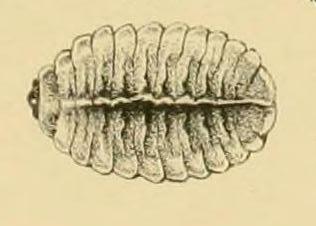
early larva, black and white line drawing by H. Knight,
in Dodds & Meyrick: 'Some remarkable ant-friend Lepidoptera of Queensland',
Transactions of the Entomological Society of London, 1911, Plate XLVIII, fig. 2,
image courtesy of Biodiversity Heritage Library,
digitized by Smithsonian Libraries.
The caterpillars of this species are carnivorous.
The early instars
are flat and segmented, and look like mites.
Initially the caterpillars are yellow, later turning pink.
They feed on
Leaf Hoppers
(
CICADELLIDAE ).
The caterpillars then form a pink cocoon.
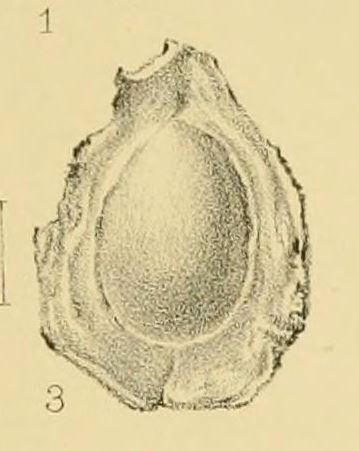
first cocoon, black and white line drawing by H. Knight,
in Dodds & Meyrick: 'Some remarkable ant-friend Lepidoptera of Queensland',
Transactions of the Entomological Society of London, 1911, Plate XLVIII, fig 3,
image courtesy of Biodiversity Heritage Library,
digitized by Smithsonian Libraries.
The later instars emerge after a few days, and are taken by
Meat Ants ( Iridomyrmex purpureus,
FORMICIDAE ),
into the Ants' nest, where the caterpillars feed on the ant larvae.
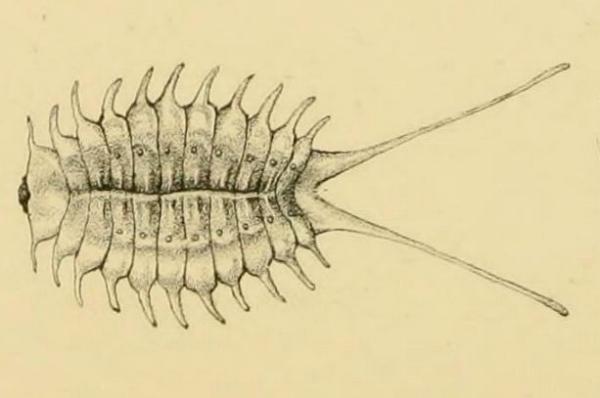
late instar larva, black and white line drawing by H. Knight,
in Dodds & Meyrick: 'Some remarkable ant-friend Lepidoptera of Queensland',
Transactions of the Entomological Society of London, 1911, Plate XLVIII, fig. 4,
image courtesy of Biodiversity Heritage Library,
digitized by Smithsonian Libraries.
These later instar caterpillars are thought to emit a
kairomone that
induces ants to take the caterpillars into the ants' nest.
These later instars are red and flattened, with soft pointed processes
sticking out the sides of each segment,
and with elongated processes on the last segment.
As these caterpillars grow, the processes do not grow,
and so become less noticeable.
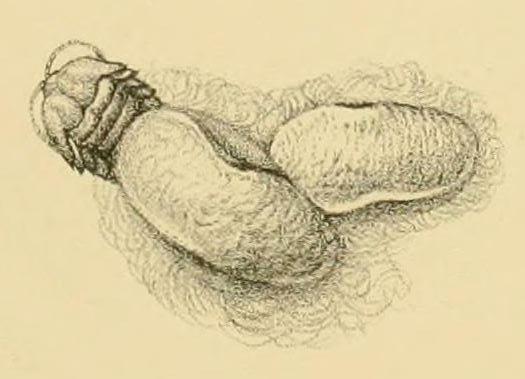
final cocoon, black and white line drawing by H. Knight,
in Dodds & Meyrick: 'Some remarkable ant-friend Lepidoptera of Queensland',
Transactions of the Entomological Society of London, 1911, Plate XLVIII, fig. 6,
image courtesy of Biodiversity Heritage Library,
digitized by Smithsonian Libraries.
The mature caterpillars leave the ant nest, and pupate in a cocoon
under some bark or other crevice.
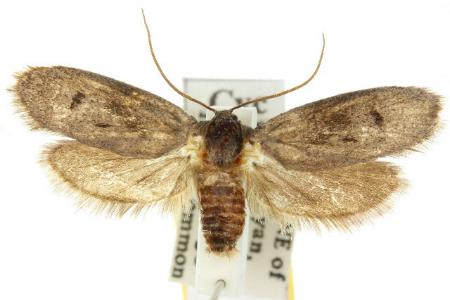
(Photo: courtesy of CSIRO/BIO Photography Group,
Centre for Biodiversity Genomics,
University of Guelph)
Adult moths have dark brown wings,
with a two dark spots and a dark dash on each forewing.
The wingspan of the male moths is about 2 cms.
The wingspan of the female moths is about 2.5 cms.

(Photo: courtesy of CSIRO/BIO Photography Group,
Centre for Biodiversity Genomics,
University of Guelph)
The eggs are off-white and ellipsoidal, with ridges of little knobs.
They are laid lying sideways in an irregular row
along a twig or piece of bark of a plant with Leaf Hoppers on it.
The eggs have a length of about 0.5 mm.
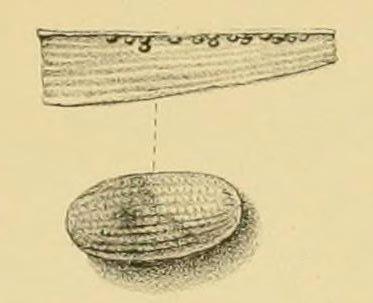
row of eggs, with close-up of one egg, black and white line drawing by H. Knight,
in Dodds & Meyrick: 'Some remarkable ant-friend Lepidoptera of Queensland',
Transactions of the Entomological Society of London, 1911, Plate XLVIII, fig 1,
image courtesy of Biodiversity Heritage Library,
digitized by Smithsonian Libraries.
The species has been found in Australia in
Western Australia,
Northern Territory,
Queensland,
New South Wales, and
South Australia.
Further reading :
Edward Meyrick,
Supplement to F.P. Dodds' Some remarkable ant-friend Lepidoptera of Queensland,
Transactions of the Entomological Society of London,
1911, pp. 589-590 and also
Plate 48, figs. 12-15.
(written 2 April 2017, updated 19 October 2025)












